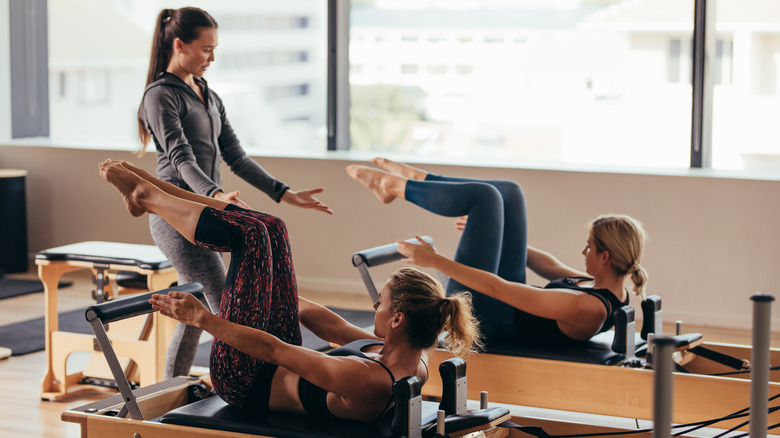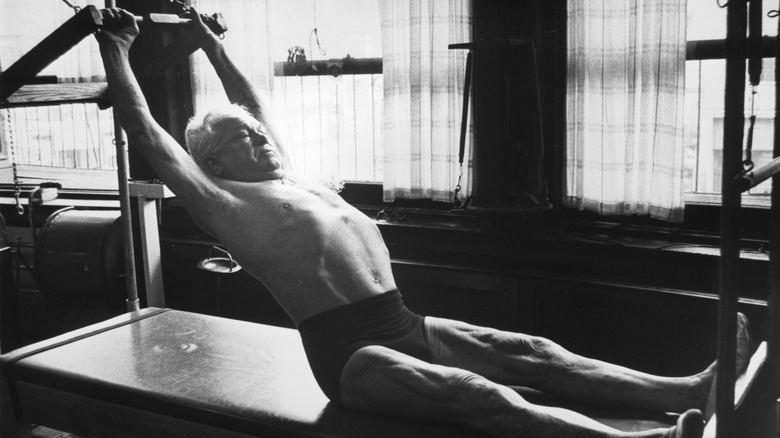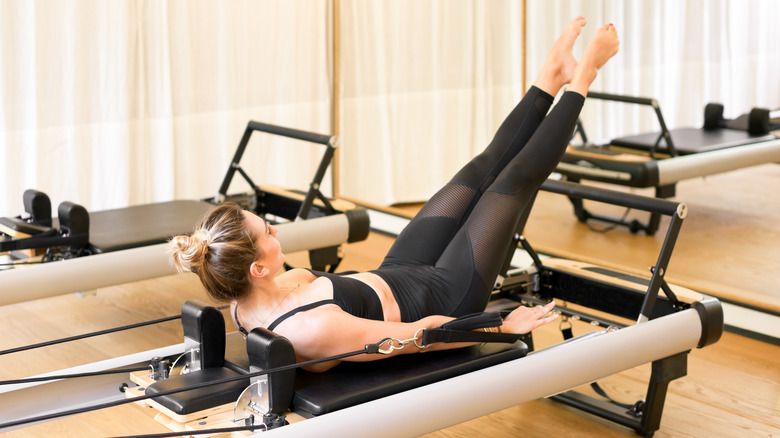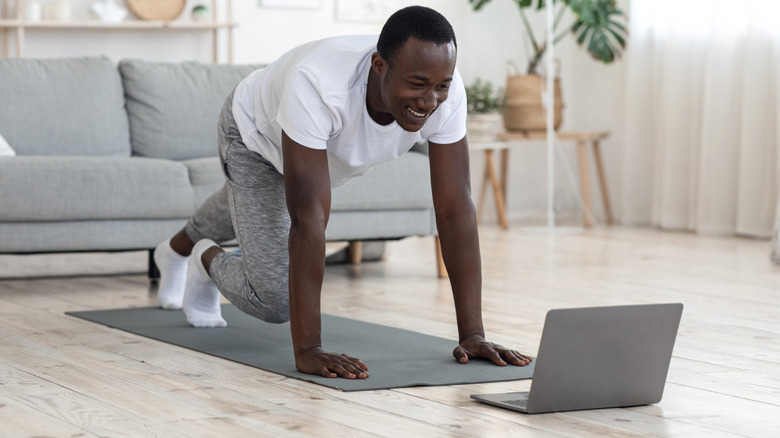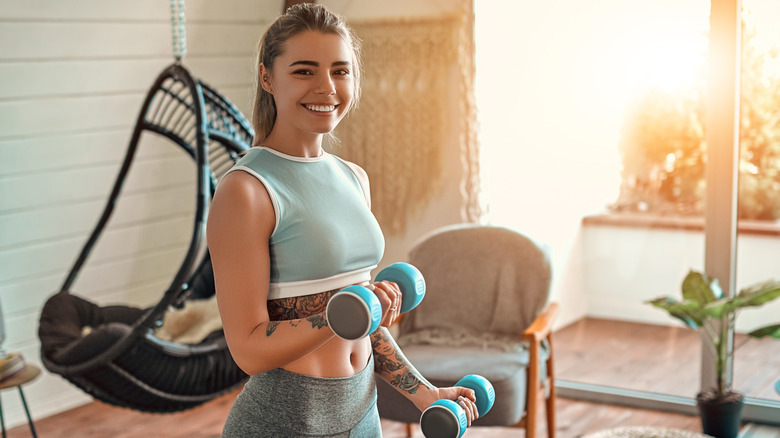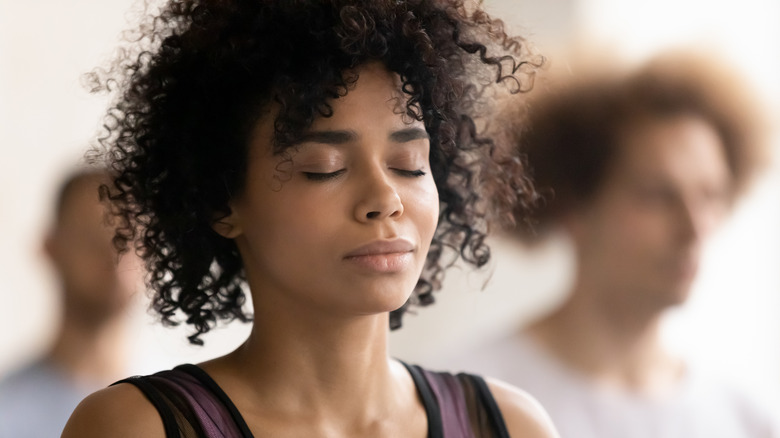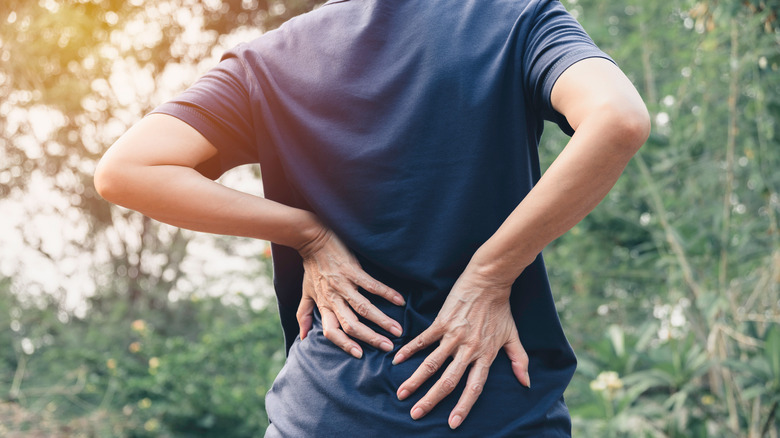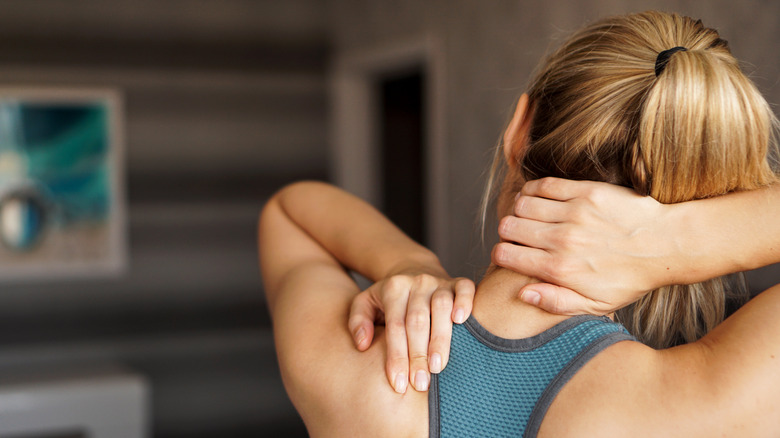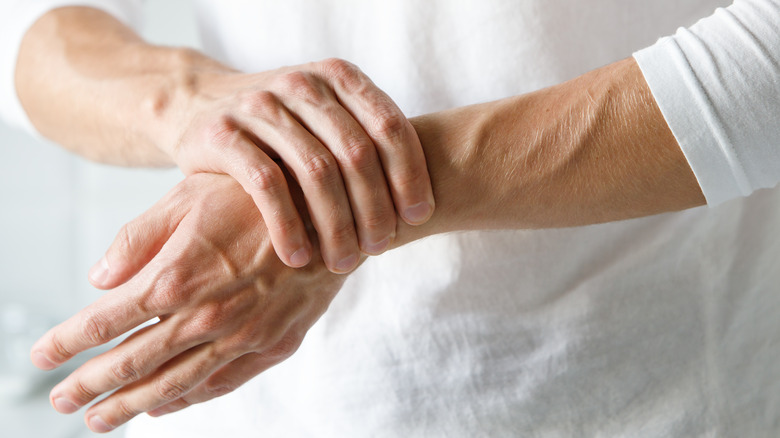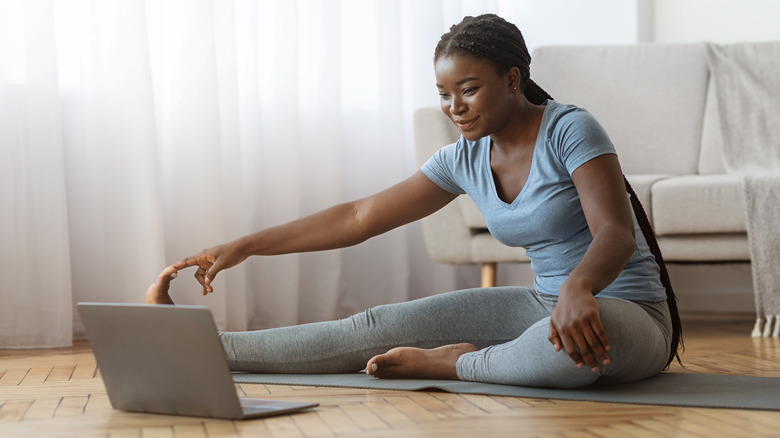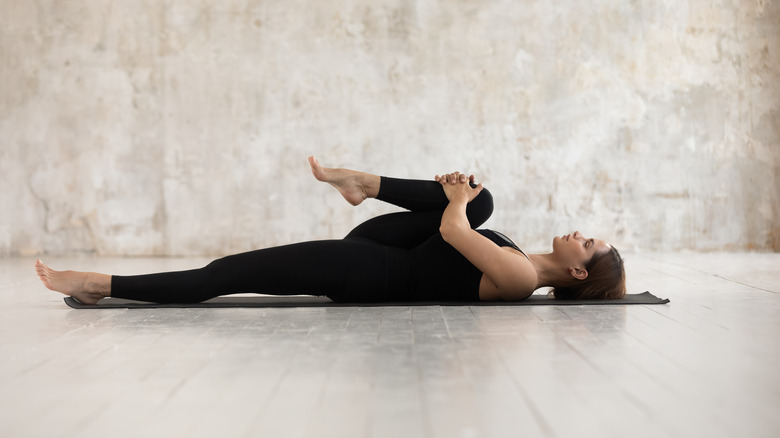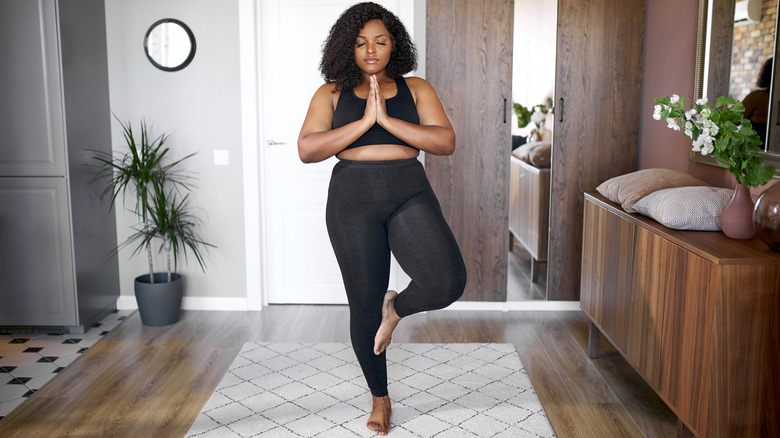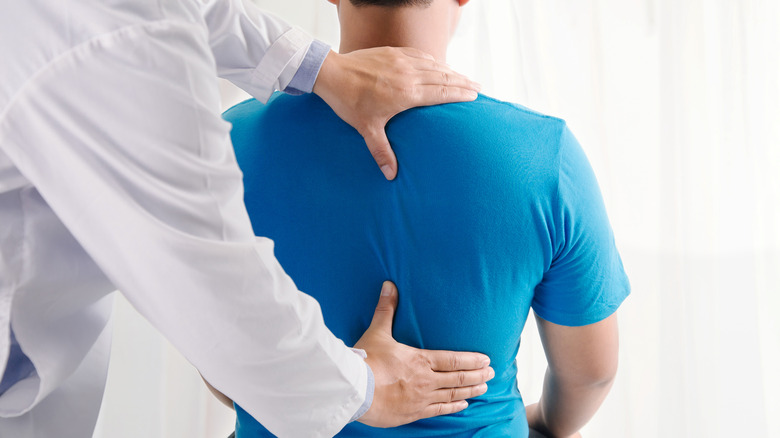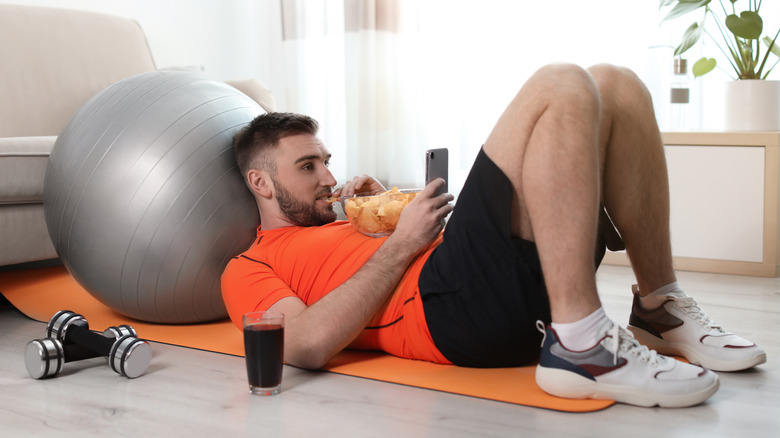When You Do Pilates Every Day, This Is What Happens To You
If you're after a low-impact, gentle way to work out, Pilates could be the way to go. With over 9 million people in the U.S. taking part in Pilates regularly as of 2018, according to Statista), this is a workout regime with significant appeal and staying power. And for good reason too. "Pilates is a full-body exercise method that will help you do everything better. It strengthens and stabilizes your core body, which is your foundation so that you can move efficiently while improving your posture, flexibility, and mobility," Sonja Herbert, a Pilates instructor and founder of Black Girl Pilates, told Self.
Sounds pretty good, right? But if you've never taken Pilates before (or even if you have), it can feel a little intimidating to navigate machines like the reformer or the Wunda. What's more, it's one thing to know that it could be good for you, and another to know exactly how that could be the case. Need a little extra info to decide if a daily Pilates practice could be a good choice for your needs? Health Digest has you covered.
The history of Pilates
Ever wondered where the word Pilates actually comes from? It's actually from the name of the founder of the method. Pilates was the brainchild of Joseph Pilates, a German physical trainer who pioneered the method in the early 20th century. Born near Dusseldorf in 1883, Joseph Pilates developed a passion for physical fitness after experiencing rickets, asthma, and rheumatic fever as a child, which spurred his adult passions that included boxing, gymnastics, diving, and skiing, according to the Pilates Foundation.
Interned in Britain during World War I, Pilates prototyped an early version of the Cadillac machine (now used around the world in fitness classes) to help patients with mobility while he worked in a hospital. After he moved to the United States in the 1920s, Pilates and his wife Clara developed the method further, which became popular with the New York dance community members. Clara eventually took charge of the teaching, and Pilates continued to grow in popularity and be passed down through generations, eventually becoming the global phenomenon that we know today.
You'll develop a stronger core by doing Pilates every day
As a full-body exercise method, much of a Pilates workout is centered around core movements. As a result, doing Pilates every day means that you'll get a top-notch core workout. "That deep core engagement building to external layers is at the base of the Pilates practice which enhances everyday movement to athletic performance," Gede Foster, Pilates instructor and FIIT head coach, told Women's Health. Core strength is central to essentially every physical activity we do, so it's certainly important to work your core.
It's also useful to remember that while we often think of our core as our abdominal muscles, it also encompasses the back muscles on the torso, diaphragm, pelvic floor muscles, and many other deep muscles in the body, as Everyone Active pointed out. Pilates exercises like "swimming" or the seesaw help to work many core muscles effectively, whereas exercises like the teaser will target your abs more specifically.
Pilates may not seem that intense, but you'll get a whole-body workout
Much of the appeal of Pilates is due to it being a gentler form of exercise that can be done at any skill or fitness level. And while that's certainly the case, that's no reason to discount the fact that a daily Pilates regimen can actually be pretty tough and demanding on your body. "Pilates is most definitely exercise and when performed correctly it's very challenging," Aimee Victoria Long, personal trainer and founder of Body Beautiful Method, told Women's Health. "As an exercise, it counts as a muscle-strengthening workout. Plus, you're able to work the whole body through Pilates. It challenges your lower and upper body and demands core strength."
And, if you're not finding Pilates that challenging on its own, it's entirely possible to ramp it up by combining Pilates moves with other workouts. Try these exercises from Good Housekeeping, which combine Pilates techniques with HIIT moves. Exercises such as mountain climbers and plank jacks can be worked in with lower-intensity Pilates to really get your blood pumping.
If you're doing daily Pilates to build muscle, you might want to incorporate other exercises
Although Pilates engages your entire body, it's a pretty low-intensity way of working out most of the time. And while this means that it's feasible to do some form of Pilates every day without exhausting yourself too much, it also means that if you're looking to build lean muscle as an exercise goal, incorporating higher-intensity activities is advisable.
In order to build muscle effectively, you need to utilize the principles of progressive overload, as Creighton Personal Trainer asserts. And Pilates, by and large, is not intense enough to create progressive overload, and the exercises focus on engaging your slow-twitch muscle fibers, which are instrumental in increasing endurance, instead of your fast-twitch muscle fibers, which allow you to generate energy more explosively and are associated with increased mass, as you might see in Olympic sprinters (via Verywell Fit).
If you're looking to build muscle mass in addition to endurance, incorporating activities like lifting weights into your exercise regime could be a good idea to compliment your Pilates routine.
Pilates may reduce your stress and improve your mood
We can seriously get on board with exercise that helps us relax. And Pilates can do just that, due to its ability to help reduce stress and improve mood. "Breathing performed in yoga and Pilates has been shown to cause a reduction in stress and blood pressure. Deep breathing also encourages correct blood flow and helps with sleep," explained Harkirat Mahal, CEO of MotivatePT, to Net Doctor. "Pilates can improve your mood as physical activity causes endorphins to be released and causes a positive feeling in the body."
This all contributes to a better mood and positivity, as the Mental Health Foundation pointed out. This could be more pertinent than ever, with all of us still bracing from the changes that 2020 has brought and the mental health pressures that have come with that. If indoor or in-person classes are not for you, there are plenty of online classes or other ways you can engage with Pilates, as Pilates Anytime revealed.
Pilates can help you avoid and recover from injuries
If you've faced injury doing other, higher-intensity exercise, you might be pleased to hear that daily Pilates is an excellent way to work out while keeping your risk of injury at a minimum. "Pilates is a low-impact flexibility and muscular strength and endurance movements combined," says personal trainer and founder of Body Beautiful Method, Aimee Victoria Long, to Women's Health Magazine. "[It] emphasises correct postural alignment, core strength and muscle balance. It is great for ironing out muscular imbalances, injury rehabilitation and injury prevention."
Pilates' ability to help with injury or pain recovery has been shown in studies such as one conducted by Tanta University's Sports Health Science Department in the Faculty of Physical Education. The study examined the effect of regular Pilates training on rehabilitation from lower back pain in athletes. It was found that Pilates was particularly effective in aiding recovery, with the researcher heading the study recommending Pilates regimes for athletes could be instrumental in their treatment for lower back issues.
You could experience some neck pain
While daily Pilates is a great way to stay active, it's important to remember that form is everything — especially if you're just starting out. Without applying the correct form to Pilates exercises, you might find that you're experiencing some aches and pains where you might not expect.
Pay close attention to your neck muscles. Due to the nature of Pilates exercises, many of which require you to lie on your back and pull your upper body away from the mat. In doing this, you may misuse your neck muscles. If your abdominal muscles aren't being engaged fully and operating the movement, your neck muscles can activate to help and end up taking on extra tension, causing strain and pain, according to Verywell Fit.
To avoid this, bring your awareness to your body fully when performing such movements, ensuring your abdominals are the primary muscles used. This will help increase both your general efficiency in working out and their strength, lessening neck strain. A weaker back can also contribute to neck strain. Consider incorporating back-strengthening Pilates exercises like swimming or the swan to help build your back strength.
Doing Pilates every day could help ease the symptoms of rheumatoid arthritis
Rheumatoid arthritis (RA) affects around 1.3 million Americans (per Healthline). A condition that affects the lining of your joints, RA can cause individuals to have mobility issues and joint pain, according to the Mayo Clinic. This can make finding suitable exercises challenging. Nevertheless, Pilates could be a good way to not only stay moving (motion is lotion!) but may also help to ease its symptoms.
Dr. Gerardo Miranda-Comas, assistant professor of rehabilitation medicine and associate director of the sports medicine fellowship at the Icahn School of Medicine at Mount Sinai Hospital in New York City, told Everyday Health, "Individuals with RA need to stay active, and Pilates can provide many benefits, like better postural balance, spine stability, flexibility, strength, better breathing, and movement control."
By increasing your strength and flexibility through Pilates, RA flares can be better handled and you can reduce the chances of mobility loss, particularly after an RA flare, according to Carrie Macy Samper, program director and training manager for Equinox National Pilates in Los Angeles.
Pilates can improve your circulation
Doing what we can to improve the blood circulation in our bodies can benefit our health in a number of ways. By maintaining circulation, our blood and the oxygen within it keeps our organs working correctly, and vitally keeps our lungs, muscles, and heart well-oxygenated, according to the Northern Illinois Vein Clinic. Good circulation also helps keep our immune systems functioning well, due to our white blood cells being able to get around our bodies adequately.
And if you're doing Pilates every day, you're in luck, as the workout can help to improve your circulation. This is due to the emphasis on deep breathing and correct posture that Pilates encourages, both of which help to support circulation (via Complete Pilates). The postural aspects of Pilates are particularly important for this, and the strengthening of postural muscles and increased mobility of the spine both allow blood to flow more freely, allowing it to go where it needs to go and keep your insides in good order.
You'll improve your flexibility
As you might expect from an exercise regime that calls for stretching and gentle movement, daily Pilates can seriously help improve your flexibility. "Pilates focusses on lengthening and expanding the muscles, instead of bunching them up," Harkirat Mahal, CEO of MotivatePT, told Net Doctor. "This therefore allows them to become longer and leaner. You will feel taller and will become longer and leaner."
Mahal explained that the stretches you perform in Pilates are particularly designed to allow you to move more freely. "The exercises within Pilates are dynamic stretches, which mean they are active movements. A muscle is stretched but is not held in the end position, and this is usually done through movement," Mahal continued. "By using this technique of stretching this will increase your range of movement."
The upshot of being more flexible doesn't just extend to feeling a little looser; improved flexibility can help with your overall strength and exercise performance, as Healthline revealed. And as Mahal said, "Having good overall flexibility will prevent injury, improve your posture and overall health." Let's get stretching!
Pilates can improve your balance
Pilates places a strong emphasis on being aware of the exercises you're performing. As Joseph Pilates himself stated, "Concentrate on the correct movement each time you exercise, lest you do them improperly and thus lose all vital benefits" (via Pilates Scan).
While this seems like a fairly obvious thing, it's easy to move through exercises without thinking about what you're doing. However, one of the benefits of concentration is an increased awareness of balance throughout your body. As MotivatePT CEO Harkihat Mahal told Net Doctor, "Pilates exercises require more thought than other workouts that rely on only repetition, which, of course, has the added benefit of keeping the mind active and alert. You don't just have to learn a series of movements; you must also learn the concept."
Mahal used the illustration of standing on one leg while opening and closing your eyes. This may be difficult at first. "But with slow movements of the limbs while maintaining a strong core, your balance will quickly improve," the expert continued. Working on your balance can not only help with injury prevention but can also help with athletic performance, as Athletico revealed.
Pilates is a good fit for pregnant people
Pregnancy can be a huge change in people's lives, and with that change can naturally come increased levels of stress and anxiety. Finding ways to manage this during pregnancy is important, and one way that could be helpful to reduce symptoms of stress or anxiety could be through Pilates.
This was shown in a review of studies published by the International Journal of Humanities and Social Science, which looked at the effects of both Pilates and muscle relaxation therapy (or MRT) on stress and anxiety during pregnancy. The review found positive correlations between Pilates and stress reduction, noting that even a single session of Pilates can result in an increased mood. The review authors ultimately stated that "both Pilates ... and progressive MRT ... are cost-effective and relatively easy methods that can be used to reduce anxiety and stress. Pilates is well suited for pregnant women as it involves low impact exercise that offer emotional, mental and physical benefits." If you've never done Pilates before and want to start during pregnancy, be sure to consult your doctor first.
Will Pilates hurt or help your back?
Regular or daily Pilates can help to increase the range of motion in the backs, stretch out tight muscles and improve posture and spinal alignment, all of which can aid ease an aching back (per Pilates Anytime).
However, performing Pilates incorrectly has the potential to cause more problems than it solves, due to the risk of injury. "I'm seeing an increasing number of patients who have muscular strains or aggravated degenerate discs after attending Pilates classes because they thought it would help with their back problems," Stewart Tucker, an orthopedic and spinal surgeon at the Royal National Orthopaedic Hospital, London, told the Daily Mail. "While I recommend it for back pain and after injury, if exercises are carried out incorrectly they can weaken the back and cause existing conditions to deteriorate."
To avoid back pain or injury during Pilates, make sure to take things slow, and really focus on alignment and correct form. When in doubt, ask your Pilates instructor to advise you on how best to move to keep injury risk low.
Doing Pilates every day could get repetitive
Let's be real for a sec: Doing any exercise every day is going to get a little bit samey, and Pilates is no exception. It's certainly gentle enough to do every day, but by working through the same routine, day in and day out, we can get lax when it comes to form and proper movement. We can also be tempted to skip the exercises we don't love.
Women's Health consulted Lynne Robinson, Pilates trainer and co-founder of Body Control Pilates, and revealed that this is where a lot of people slip up. "We tend to do the exercises that we like doing and they're often the ones we shouldn't do — we actually need to do the ones we don't like," the site divulged. "For example if you're on the computer a lot, you'll naturally become quite round shouldered, so curl ups are really no good. You have to do your darts, your back extensions to reverse it."
Remember, a good Pilates workout is designed in a certain way for a reason. It'll help you move your body in a way that'll benefit you, skipping other forms of exercise isn't necessarily a good idea.

